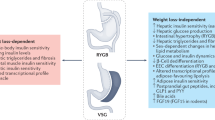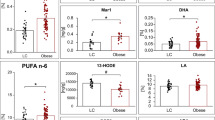Abstract
Background
Roux-en-Y gastric bypass (RYGB) surgery is a therapeutic intervention for morbid obesity and type 2 diabetes (T2D) that improves metabolic regulation. Follistatin (Fst) could be implicated in improved glycemia as it is highly regulated by RYGB. However, it is unknown if metabolic status, such as T2D, alters the Fst response to RYGB. In addition, the effect of RYGB on the Fst target, activin A, is unknown in individuals with obesity and T2D, but is needed to interpret the functional effects of altering Fst. Finally, whether Fst-regulated intracellular signaling contributes to beneficial effects of RYGB is undetermined.
Methods
Circulating Fst and activin A were measured before, 1 week, and 1 year after RYGB surgery in a total of 20 individuals with obesity, 10 with normoglycemia (NGT) and 10 with preoperative T2D. Intracellular signaling downstream of the Activin receptor type IIB (ActRIIB) signaling pathway was analyzed in skeletal muscle and adipose tissue.
Results
The doubling in circulating Fst observed in subjects with NGT 1-week and 1-year post surgery was absent in T2D. After 1 week, RYGB reduced activin A by 27% (p < 0.001) and 20% (p < 0.01) in subjects with NGT and T2D, respectively; a reduction that tended to be maintained in the subjects with T2D at 1-year post-RYGB (−15%; p = 0.0592). RYGB had no effects on skeletal muscle ActRIIB signaling. In contrast, adipose tissue phosphorylation of SMAD2Ser465/467, p70S6KThr389, S6RPSer235/236, and 4E-BP1Thr37/49 was highly regulated, particularly 1-year post-RYGB (p < 0.05).
Conclusions
In subjects with preoperative T2D, RYGB did not increase circulating Fst contrasting subjects with NGT, while the reduction in activin A was maintained. ActRIIB signaling was upregulated in adipose tissue, but not skeletal muscle, following RYGB in both individuals with NGT and T2D. Our results suggest a role of adipose tissue ActRIIB signaling for the beneficial effects of RYGB surgery.
This is a preview of subscription content, access via your institution
Access options
Subscribe to this journal
Receive 12 print issues and online access
$259.00 per year
only $21.58 per issue
Buy this article
- Purchase on Springer Link
- Instant access to full article PDF
Prices may be subject to local taxes which are calculated during checkout




Similar content being viewed by others
References
Schauer PR, Mingrone G, Ikramuddin S, Wolfe B. Clinical outcomes of metabolic surgery: efficacy of glycemic control, weight loss, and remission of diabetes. Diabetes Care. 2016;39:902–11.
Schauer PR, Bhatt DL, Kirwan JP, Wolski K, Aminian A, Brethauer SA, et al. Bariatric surgery versus intensive medical therapy for diabetes—5-year outcomes. N Engl J Med. 2017;376:641–51.
Albers PH, Bojsen-Moller KN, Dirksen C, Serup AK, Kristensen DE, Frystyk J, et al. Enhanced insulin signaling in human skeletal muscle and adipose tissue following gastric bypass surgery. Am J Physiol Regul Integr Comp Physiol. 2015;309:R510–24.
Bojsen-Moller KN, Dirksen C, Jorgensen NB, Jacobsen SH, Serup AK, Albers PH, et al. Early enhancements of hepatic and later of peripheral insulin sensitivity combined with increased postprandial insulin secretion contribute to improved glycemic control after Roux-en-Y gastric bypass. Diabetes. 2014;63:1725–37.
Furet JP, Kong LC, Tap J, Poitou C, Basdevant A, Bouillot JL, et al. Differential adaptation of human gut microbiota to bariatric surgery-induced weight loss: links with metabolic and low-grade inflammation markers. Diabetes. 2010;59:3049–57.
Clemmensen C, Muller TD, Woods SC, Berthoud HR, Seeley RJ, Tschop MH. Gut-Brain cross-talk in metabolic control. Cell. 2017;168:758–74.
Kota J, Handy CR, Haidet AM, Montgomery CL, Eagle A, Rodino-Klapac LR, et al. Follistatin gene delivery enhances muscle growth and strength in nonhuman primates. Sci Transl Med. 2009;1:6ra15.
Mendell JR, Sahenk Z, Al-Zaidy S, Rodino-Klapac LR, Lowes LP, Alfano LN, et al. Follistatin gene therapy for sporadic inclusion body myositis improves functional outcomes. Mol Ther. 2017;25:870–9.
Sepulveda PV, Lamon S, Hagg A, Thomson RE, Winbanks CE, Qian H, et al. Evaluation of follistatin as a therapeutic in models of skeletal muscle atrophy associated with denervation and tenotomy. Sci Rep. 2015;5:17535.
Garito T, Roubenoff R, Hompesch M, Morrow L, Gomez K, Rooks D, et al. Bimagrumab improves body composition and insulin sensitivity in insulin-resistant individuals. Diabetes Obes Metab. 2018;20:94–102.
Han X, Moller LLV, De Groote E, Bojsen-Moller KN, Davey J, Henriquez-Olguin C, et al. Mechanisms involved in follistatin-induced hypertrophy and increased insulin action in skeletal muscle. J Cachexia Sarcopenia Muscle. 2019;10:1241–57.
Hansen JS, Rutti S, Arous C, Clemmesen JO, Secher NH, Drescher A, et al. Circulating follistatin Is liver-derived and regulated by the glucagon-to-insulin ratio. J Clin Endocrinol Metab. 2016;101:550–60.
Latres E, Mastaitis J, Fury W, Miloscio L, Trejos J, Pangilinan J, et al. Activin A more prominently regulates muscle mass in primates than does GDF8. Nat Commun. 2017;8:15153.
Han HQ, Zhou X, Mitch WE, Goldberg AL. Myostatin/activin pathway antagonism: molecular basis and therapeutic potential. Int J Biochem Cell Biol. 2013;45:2333–47.
Amthor H, Nicholas G, McKinnell I, Kemp CF, Sharma M, Kambadur R, et al. Follistatin complexes Myostatin and antagonises Myostatin-mediated inhibition of myogenesis. Dev Biol. 2004;270:19–30.
Nakatani M, Takehara Y, Sugino H, Matsumoto M, Hashimoto O, Hasegawa Y, et al. Transgenic expression of a myostatin inhibitor derived from follistatin increases skeletal muscle mass and ameliorates dystrophic pathology in mdx mice. FASEB J. 2008;22:477–87.
Winbanks CE, Weeks KL, Thomson RE, Sepulveda PV, Beyer C, Qian H, et al. Follistatin-mediated skeletal muscle hypertrophy is regulated by Smad3 and mTOR independently of myostatin. J Cell Biol. 2012;197:997–1008.
Rooks D, Praestgaard J, Hariry S, Laurent D, Petricoul O, Perry RG, et al. Treatment of sarcopenia with bimagrumab: results from a phase II, randomized, controlled, proof-of-concept study. J Am Geriatr Soc. 2017;65:1988–95.
Braga M, Reddy ST, Vergnes L, Pervin S, Grijalva V, Stout D, et al. Follistatin promotes adipocyte differentiation, browning, and energy metabolism. J Lipid Res. 2014;55:375–84.
Singh R, Braga M, Reddy ST, Lee SJ, Parveen M, Grijalva V, et al. Follistatin targets distinct pathways to promote brown adipocyte characteristics in brown and white adipose tissues. Endocrinology. 2017;158:1217–30.
Hansen J, Rinnov A, Krogh-Madsen R, Fischer CP, Andreasen AS, Berg RM, et al. Plasma follistatin is elevated in patients with type 2 diabetes: relationship to hyperglycemia, hyperinsulinemia, and systemic low-grade inflammation. Diabetes Metab Res Rev. 2013;29:463–72.
Teede H, Ng S, Hedger M, Moran L. Follistatin and activins in polycystic ovary syndrome: relationship to metabolic and hormonal markers. Metab Clin Exp. 2013;62:1394–400.
Yndestad A, Haukeland JW, Dahl TB, Bjoro K, Gladhaug IP, Berge C, et al. A complex role of activin A in non-alcoholic fatty liver disease. Am J Gastroenterol. 2009;104:2196–205.
Perakakis N, Mougios V, Fatouros I, Siopi A, Draganidis D, Peradze N, et al. Physiology of activins/follistatins: associations with metabolic and anthropometric variables and response to exercise. J Clin Endocrinol Metab. 2018;103:3890–9.
Perakakis N, Kokkinos A, Peradze N, Tentolouris N, Ghaly W, Tsilingiris D, et al. Follistatins in glucose regulation in healthy and obese individuals. Diabetes Obes Metab. 2019;21:683–90.
Tao R, Wang C, Stohr O, Qiu W, Hu Y, Miao J, et al. Inactivating hepatic follistatin alleviates hyperglycemia. Nat Med. 2018;24:1058–69.
Zhang YQ, Kanzaki M, Shibata H, Kojima I. Regulation of the expression of follistatin in rat hepatocytes. Biochim Biophys Acta. 1997;1354:204–10.
Welinder C, Ekblad L. Coomassie staining as loading control in Western blot analysis. J Proteome Res. 2011;10:1416–9.
Perakakis N, Kokkinos A, Peradze N, Tentolouris N, Ghaly W, Tsilingiris D, et al. Metabolic regulation of activins in healthy individuals and in obese patients undergoing bariatric surgery. Diabetes Metab Res Rev. 2020;36:e3297.
Motevalli MS, Dalbo VJ, Attarzadeh RS, Rashidlamir A, Tucker PS, Scanlan AT. The effect of rate of weight reduction on serum myostatin and follistatin concentrations in competitive wrestlers. Int J Sports Physiol Perform. 2015;10:139–46.
Sylow L, Vind BF, Kruse R, Moller PM, Wojtaszewski JFP, Richter EA, et al. Circulating follistatin and activin A and their regulation by insulin in obesity and type 2 diabetes. J Clin Endocrinol Metab. 2020;105:1343–54.
Sakamoto Y, Shintani Y, Harada K, Abe M, Shitsukawa K, Saito S. Determination of free follistatin levels in sera of normal subjects and patients with various diseases. Eur J Endocrinol. 1996;135:345–51.
Shimonaka M, Inouye S, Shimasaki S, Ling N. Follistatin binds to both activin and inhibin through the common subunit. Endocrinology. 1991;128:3313–5.
Thompson TB, Lerch TF, Cook RW, Woodruff TK, Jardetzky TS. The structure of the follistatin:activin complex reveals antagonism of both type I and type II receptor binding. Dev Cell. 2005;9:535–43.
McConnell DS, Wang Q, Sluss PM, Bolf N, Khoury RH, Schneyer AL, et al. A two-site chemiluminescent assay for activin-free follistatin reveals that most follistatin circulating in men and normal cycling women is in an activin-bound state. J Clin Endocrinol Metab. 1998;83:851–8.
Gancheva S, Ouni M, Jelenik T, Koliaki C, Szendroedi J, Toledo FGS, et al. Dynamic changes of muscle insulin sensitivity after metabolic surgery. Nat Commun. 2019;10:4179.
Hoffstedt J, Andersson DP, Eriksson Hogling D, Theorell J, Naslund E, Thorell A, et al. Long-term protective changes in adipose tissue after gastric bypass. Diabetes Care. 2017;40:77–84.
Cai H, Dong LQ, Liu F. Recent advances in adipose mTOR signaling and function: therapeutic prospects. Trends Pharmacol Sci. 2016;37:303–17.
Flanagan JN, Linder K, Mejhert N, Dungner E, Wahlen K, Decaunes P, et al. Role of follistatin in promoting adipogenesis in women. J Clin Endocrinol Metab. 2009;94:3003–9.
Inouye S, Guo Y, DePaolo L, Shimonaka M, Ling N, Shimasaki S. Recombinant expression of human follistatin with 315 and 288 amino acids: chemical and biological comparison with native porcine follistatin. Endocrinology. 1991;129:815–22.
Sidis Y, Mukherjee A, Keutmann H, Delbaere A, Sadatsuki M, Schneyer A. Biological activity of follistatin isoforms and follistatin-like-3 is dependent on differential cell surface binding and specificity for activin, myostatin, and bone morphogenetic proteins. Endocrinology. 2006;147:3586–97.
Kimura F, Sidis Y, Bonomi L, Xia Y, Schneyer A. The follistatin-288 isoform alone is sufficient for survival but not for normal fertility in mice. Endocrinology. 2010;151:1310–9.
Acknowledgements
We acknowledge the skilled technical assistance of Betina Bolmgren, Dorte E. Steenberg, and Peter H. Albers (Molecular Physiology Group, Department of Nutrition, Exercise and Sports, Faculty of Science, University of Copenhagen, Denmark; Diabetes Research Unit, Novo Nordisk A/S, Maaloev, Denmark). We also wish to thank all the subjects participating in this study.
Funding
This work was carried out as a part of the program of the UNIK: Food, Fitness & Pharma for Health and Disease (see www.foodfitnesspharma.ku.dk). The UNIK project was supported by the Danish Ministry of Science, Technology and Innovation, the Danish Council for Independent Research Medical Sciences (FSS), the Novo Nordisk Foundation, and the Strategic Counsel for the Capital Area of Copenhagen (Denmark). The study was further supported by the Novo Nordisk Foundation (grant NNF16OC0023418 and NNF18OC0032082 to LS).
Author information
Authors and Affiliations
Corresponding author
Ethics declarations
Conflict of interest
The authors declare that they have no conflict of interest.
Ethical approval
Clinical experiments were approved by the Ethics Committee of Copenhagen and complied with the ethical guidelines of the Declaration of Helsinki II 2000.
Informed consent
Written informed consent was obtained from all participants prior to the study start. The clinical study is registered at www.ClinicalTrials.gov (NCT01202526).
Additional information
Publisher’s note Springer Nature remains neutral with regard to jurisdictional claims in published maps and institutional affiliations.
Supplementary information
Rights and permissions
About this article
Cite this article
Pham, T.C.P., Bojsen-Møller, K.N., Madsbad, S. et al. Effects of Roux-en-Y gastric bypass on circulating follistatin, activin A, and peripheral ActRIIB signaling in humans with obesity and type 2 diabetes. Int J Obes 45, 316–325 (2021). https://doi.org/10.1038/s41366-020-00664-7
Received:
Revised:
Accepted:
Published:
Issue Date:
DOI: https://doi.org/10.1038/s41366-020-00664-7



